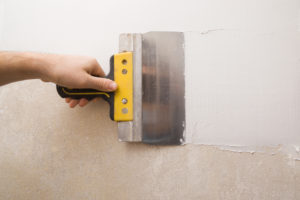Wall putty comes in a couple of popular types, spackling and wall compound. Know the difference so you can pick the right one for your project.

Wall Putty 101
Remember that time your kids rode their bikes inside and the pedals dinged the hallway walls? Or what about those scars left by the nails you pulled out when you moved pictures? Wall putty to the rescue! Before you paint, cover those scars with this magical paste and no one will ever know they were there.
Let’s talk about the difference between the two main painters’ putties, spackling and joint compound. There are a few differentiators, mainly:
- Project scope
- Drying time
- Shrinkage
Spackle comes in small tubs and has the consistency of fluffy toothpaste. Made from gypsum powder and binders (sometimes with a little vinyl mixed in), it’s used to repair small dents and holes, like nail holes.
It dries faster than any of the other putties (about 30 minutes) and shrinks less, meaning you can often fix the hole in one coat. And because it dries quickly, you can sand and paint over it almost as soon as you apply it.
Joint compound, also called drywall mud, is used for bigger jobs, most commonly by painters who are hanging drywall. This gypsum-and-water mix has the consistency of cake frosting, and it’s blended on the job. Painters hang the drywall, tape the seams between boards, and apply joint compound over the tape. This hides the seams, creating a smooth surface.
Spackle’s quick-drying nature means it’s not a good fit for mudding. But mud can be used in place of spackle. Because of the longer drying times and tendency to shrink, though, you may have to apply more than one coat and wait 24-48 hours before you paint.
How To Putty a Wall Before Painting
Pro tip: Work quickly and keep your putty covered when you’re not using it. If you’re mixing your own mud, only make what you need for your job.
When you’re patching drywall or plaster, filling holes smaller than a half-inch, use a premixed spackle.
- Remove any loose drywall
- Smooth on the spackle with a putty knife, angling it about 45 degrees and swiping downward until the hole is filled
- Scrape off the extra spackle
- Let dry
- Apply another coat if needed
- Sand gently and wipe away dust
- Paint
For bigger holes or cracks in plaster or drywall, use joint compound and a reinforcing mesh. That’s a type of backing material made of aluminum that gives the mud something to bind to. It helps ensure that the mud won’t dry and crumble with time.
- Apply the mesh to the drywall, covering the hole completely
- Smooth on the joint compound
- Let it dry and, if needed, apply another coat
- Sand
- Finish
For bigger holes, use a large piece of drywall reinforced with mesh or lumber, and smooth on some joint compound.
Are you ready for smooth walls or a new coat of paint? Reach out for a free virtual quote. Or talk color schemes with us – we’ll even send you free 8” x 8” paint samples.